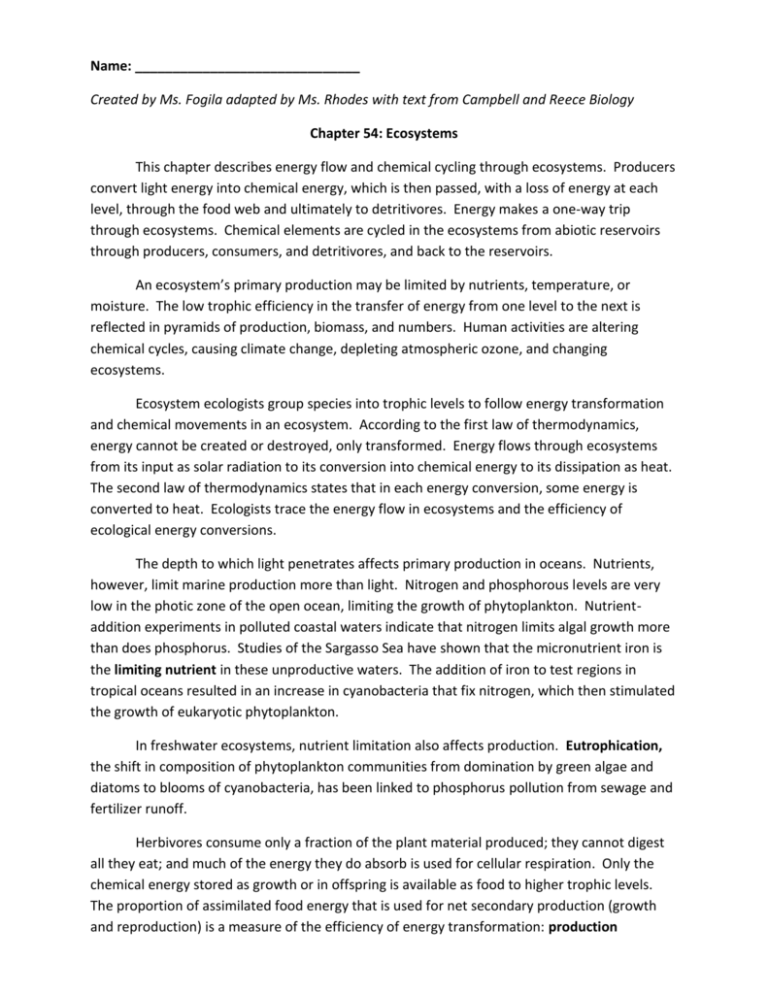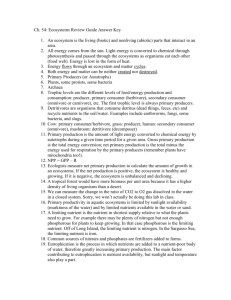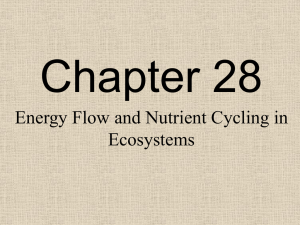Name
advertisement

Name: ______________________________ Created by Ms. Fogila adapted by Ms. Rhodes with text from Campbell and Reece Biology Chapter 54: Ecosystems This chapter describes energy flow and chemical cycling through ecosystems. Producers convert light energy into chemical energy, which is then passed, with a loss of energy at each level, through the food web and ultimately to detritivores. Energy makes a one-way trip through ecosystems. Chemical elements are cycled in the ecosystems from abiotic reservoirs through producers, consumers, and detritivores, and back to the reservoirs. An ecosystem’s primary production may be limited by nutrients, temperature, or moisture. The low trophic efficiency in the transfer of energy from one level to the next is reflected in pyramids of production, biomass, and numbers. Human activities are altering chemical cycles, causing climate change, depleting atmospheric ozone, and changing ecosystems. Ecosystem ecologists group species into trophic levels to follow energy transformation and chemical movements in an ecosystem. According to the first law of thermodynamics, energy cannot be created or destroyed, only transformed. Energy flows through ecosystems from its input as solar radiation to its conversion into chemical energy to its dissipation as heat. The second law of thermodynamics states that in each energy conversion, some energy is converted to heat. Ecologists trace the energy flow in ecosystems and the efficiency of ecological energy conversions. The depth to which light penetrates affects primary production in oceans. Nutrients, however, limit marine production more than light. Nitrogen and phosphorous levels are very low in the photic zone of the open ocean, limiting the growth of phytoplankton. Nutrientaddition experiments in polluted coastal waters indicate that nitrogen limits algal growth more than does phosphorus. Studies of the Sargasso Sea have shown that the micronutrient iron is the limiting nutrient in these unproductive waters. The addition of iron to test regions in tropical oceans resulted in an increase in cyanobacteria that fix nitrogen, which then stimulated the growth of eukaryotic phytoplankton. In freshwater ecosystems, nutrient limitation also affects production. Eutrophication, the shift in composition of phytoplankton communities from domination by green algae and diatoms to blooms of cyanobacteria, has been linked to phosphorus pollution from sewage and fertilizer runoff. Herbivores consume only a fraction of the plant material produced; they cannot digest all they eat; and much of the energy they do absorb is used for cellular respiration. Only the chemical energy stored as growth or in offspring is available as food to higher trophic levels. The proportion of assimilated food energy that is used for net secondary production (growth and reproduction) is a measure of the efficiency of energy transformation: production efficiency = net secondary production/assimilation of primary production. Production efficiencies vary from 1-3% for “warm-blooded” birds and mammals, to 10% for fishes, to 40% for insects. Temperature and the availability of water and O2 influence decomposition rates; thus, nutrient cycle rapidly in a tropical rain forest; the soil contains only about 10% of the ecosystem’s nutrients. In temperate forests where decomposition is slower, 50% of organic nutrients are stored in the detritus and soil. Decomposition rates are slow in aquatic ecosystems, and sediments constitute a nutrient sink. The harvesting of crops removes nutrients that would otherwise recycle in the soil. After depleting the organic and inorganic reserves of nutrients, crops require the addition of synthetic fertilizers. The burning of coal and other fossil fuels as well as wood releases oxides of sulfur and nitrogen, which form sulfuric and nitric acid in the atmosphere. These acids return to the earth as acid precipitation, defined as rain, snow, or fog with pH less than 5.6 Nutrients leach from soils as acid precipitation changes soil chemistry, and forests have been damaged. Fish populations in lakes across North America and Europe have declined and community compositions have changed. Humans release a huge variety of toxic chemicals into the environment. Organisms absorb these toxins form food and water and may retain them within their tissures. IN a process known as biological magnification, the concentration of such compounds increases in each successive link of the food chain. Chlorinated hydrocarbons, such as DDT, and polychlorinated biphenyls, of PCBs, have been implicated in endocrine system problems in many animal species. Many toxic chemicals dumped into ecosystems are non-biodegradable; others, such as mercury, may become more harmful as they react with other environmental factors. Root words: Detrit: wear off Vora: eat 1. How does the definition of ecosystems expand on the concept of the community? 2. Define the following energy budget terms: a. Primary productivity: b. Gross primary productivity: c. Net primary productivity 3. Why is the open ocean so low in productivity, based on per unit area? 4. What is secondary productivity? 5. Is it possible to have sixth degree carnivore? Explain. 6. Why is it essential that elements move through biogeochemical cycles in the ecosystem? 7. What are the major processes that move carbon through the ecosystem? 8. What is the impact of combustion on the carbon cycles? 9. What is the source of acid rain? 10. Why is acid rain a problem? 11. What happens in biological magnification? 12. What would be some of the properties of molecules that could be candidates for biological magnification? 13. What are the possible reasons for global warming called the greenhouse effect? 14. What is the cause for the depletion of the ozone layer? Why is it a problem? 15. Which of the following groups is absolutely essential to the function of an ecosystem? a. Producers b. Producers and herbivores c. Producers, herbivores, and carnivores d. Detritivores e. Producers and detritivores 16. Which of the following is an accurate statement about ecosystems? a. Energy is recycled through the trophic structure. b. Energy is usually captured from sunlight by primary producers, passed to secondary producers in the form of organic compounds, and lost to detritivores in the form of heat. c. Chemicals are recycled between the biotic and abiotic sectors, whereas energy makes a one-way trip through the food web and is eventually dissipated as heat. d. There is a continuous process by which energy is lost as hear, and chemical elements leave the ecosystem through runoff. e. A food web shows that all trophic levels may feed off each other. 17. The open ocean and tropical rain forest are the two largest contributors to Earth’s net primary production because a. Both have high rates of net primary production. b. Both cover huge surface areas of Earth. c. Nutrients cycle fastest in these two ecosystems. d. The ocean covers a huge surface area and the tropical rain forest has a high rate of production. e. Both a and b are correct. 18. Production in terrestrial ecosystems is affected by a. Temperature. b. Light intensity. c. Availability of nutrients. d. Availability of water. e. All of the above. 19. In which of the following would you expect production efficiency to be the greatest? a. Plants b. Mammals c. Fish d. Insects e. Birds 20. Biogeochemical cycles are global for elements a. That are found in the atmosphere. b. That are found mainly in the soil. c. Such as carbon, nitrogen, and phosphorus. d. That are dissolved in water. e. In the non-available reservoirs. 21. Clear-cutting tropical forests yields agricultural land with limited productivity because a. It is too hot in the tropics for most food crops. b. The tropical forest re-grows rapidly and chokes out agricultural crops. c. Few of the ecosystem’s nutrients are stored in the soil; most are in the forest trees. d. Phosphorus, not nitrogen, is the limiting nutrient in those soils. e. Decomposition rates are high but primary production is low in the tropics. 22. The finding of harmful levels of DDT in grebes (fish-eating birds) following years of trying to eliminate bothersome gnat populations in a lakeshore town is an example of a. Eutrophicaion. b. Biological magnification. c. The biomass pyramid. d. Chemical cycling. e. Increasing resistance to pesticides.







